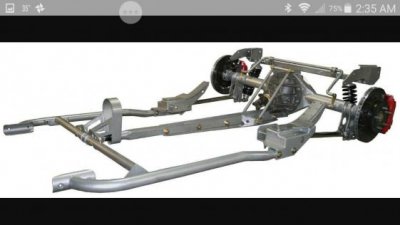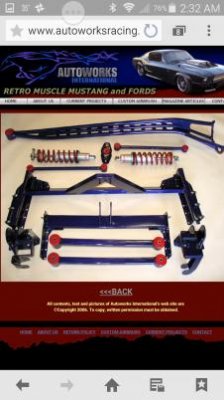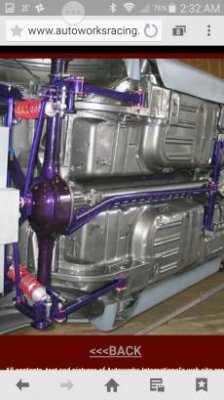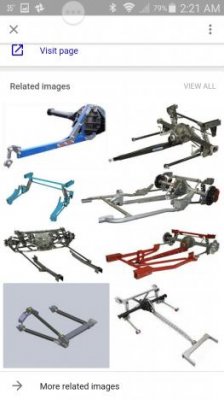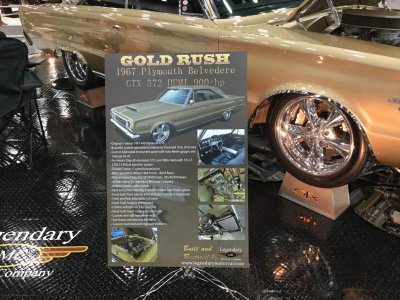Sorry 747mopar, people probably got confused with my post. I was trying to find out if torque and truck arm setups were indeed different.
Truck Arms--The NASCAR Favorite
Chances are, the only time you have seen a truck-arm style (aka center drive) rear suspension is if you looked under a NASCAR racer. Winston Cup, Busch Grand National, Craftsman Truck, and IROC drivers have been tweaking this technology for the last 30 years. Hot Rods To Hell, in Burbank, California, has been retrofitting classic cars to center drive technology for over 10 years, so we hit them up for their insight on this system. HRTH had this to say, "To start with, a truck-arm suspension cannot bind under any type of condition. The suspension stays supple, the arms converge on an actual instant center and, because of their length, they remain neutral throughout bump, droop, and roll travel. The axle travels straight up and down so the wheelbase also remains constant. Your driveshaft slip yoke barley moves, and torque-induced chassis twist is eliminated. Also, the chassis is no longer being pushed around from the rear outer extremities by short little links, or the front half of leaf springs." HRTH also mentioned that the system eliminates wheel hop and is fully adjustable. These adjustments allow you to set the ride height and still maintain a level Panhard rod.
According to mechanical engineer Katz Tsubai, "The pros of a truck arm suspension are stable IC location, good roll steer characteristics, and good yaw response. This results in consistent behavior under both acceleration and braking. As for downsides, he points out the overall weight of the system, both sprung and unsprung, is quite high. Also, since the trailing links are rigidly mounted on the axle, components must elastically deflect in order for the suspension to roll. Try visualizing the whole suspension system as a giant anti-roll bar, with the axle assembly being the bar and trailing links being arms. You can see why the system restrains the roll." It should also be noted that running a full exhaust system with this type of rear suspension is quite a challenge due to how much real estate the components eat up under the car.
Torque Arm
A torque-arm suspension uses a long arm--rigidly mounted to the rear center section--that runs from the center of the differential to a point near the transmission to absorb rear axle torque reactions. The design specification of a torque-arm setup is similar to that of a three-link style suspension. The most important factor being that the lateral location of the rear end must be kept with a low roll center to avoid unpredictable suspension responses. In this type of suspension, a Panhard bar or Watt's link is required for keeping the rear end centered. Torque-arm suspensions have been used on cars for quite some time, all the way back to the 1930s. When designed properly, this style of suspension can offer good performance characteristics. The most notable performance cars to use this suspension are Camaros and Firebirds made from 1982 to 2002. They employ a torque arm along with trailing arms and a Panhard rod.
One other concept seen when discussing torque-arm rear suspensions is "decoupling." When a torque arm is directly connected to the chassis, the rear end can physically be lifted off the ground under hard deceleration. This is referred to as "brake hop" and is something you want to avoid. By decoupling the torque arm from the chassis, you avoid the braking torque being transferred through the torque arm. This is accomplished by only letting the torque arm contact the chassis under acceleration and by allowing the other links in the system to absorb the braking torque. In this way the acceleration and braking functions are separated and each can be optimized individually.
Getting a properly functioning torque-arm suspension is not an easy task. The length of the links and their placement has to be dead-on. Also, the bushings used, damping rates, spring rates, and preload must be calculated to work together in controlling all the forces.
When we asked mechanical engineer Katz Tsubai about what he felt were the pros and cons of torque-arm suspension he said, "One pro is that the system is kinematically free in roll. As with a three-link, the suspension is free to roll when Heim joints are used. As a result, tuning is much easier and the end result is predictable and won't surprise you by causing conditions like snap-oversteer." He also pointed out that it's possible to achieve good roll steer characteristics with a low roll center. Added benefits would be that the system is fairly simple to retrofit to an older car since you do not have to cut up the floor and trunk. Additionally, depending on the layout and centering device used, it's relatively easy to route a full exhaust system.
On the down side, Katz stated that he felt the system had a low anti-squat value, depending on how the trailing links were arranged and that it's difficult to get high anti-squat without causing roll oversteer or severe brake hop. This would be more of a problem in a short-wheelbase car that would use a relatively short torque arm. Kats also related that in some cases the system has limited adjustability. Since the length of the torque arm is fixed, any changes to adjust the anti-squat value will also change the roll steer characteristics. On the subject of decoupled torque-arm setups Katz added, "The idea is to free up the torque arm from reacting to braking torque by adding a telescoping auxiliary link. This allows you to have very high anti-squat value, while keeping brake hop, which is normally associated with high anti-squat, at bay. The system is very sensitive to tuning, particularly preloading."
In practice, we've not noticed degraded anti-squat or brake hop in either factory torque arms, or the Griggs GR-40 system for late-model Mustangs. Under hard track use, the most common torque-arm designs offer adequate, or even superior, anti-squat characteristics. It's important to note that the ill-handling traits regarding torque arms apply only to short torque arms, so if you plan on fabricating one yourself, make sure you've got the real estate necessary for an effective design.
